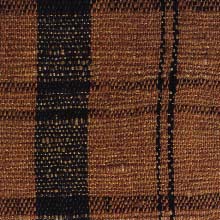Weave (p. 108 )
1. Produced in Aogakicho Hikamigun, Kyoto-Fu.
2. Characteristics: Hand woven fabric of handspun cotton. However, "Tsumami Ito," hand spun threads from waste cocoon are sometimes mixed as weft. The cloth is rough and beautiful, different from other cotton fabrics. Threads are dyed with plant dyes and the colors are only indigo, brown and green. The lightness and darkness of the 3 colors give the variations to the designs of stripes and cross stripes.
3. Uses: Farming clothes, bedding. Also loved for use as a pouch for tea caddy for tea ceremonies.
4. History: It was produced in quantity by the name of "Shima(stripe), Nuki Momen(cotton)" or "Saji Momen" in the late Edo and the middle Meiji period, but ceased in the Taisho Period. In the early Showa Period, a noted folkcraft researcher,Muneyoshi Yanagi, happened to discover it at a morning fair in Kyoto and named it "Tanba(Kyoto) Fu(cloth)." It was revived in 1954 for its preservation, with the efforts of a local group led by Yanagi and Rokuro Uemura and the technique is preserved today.



